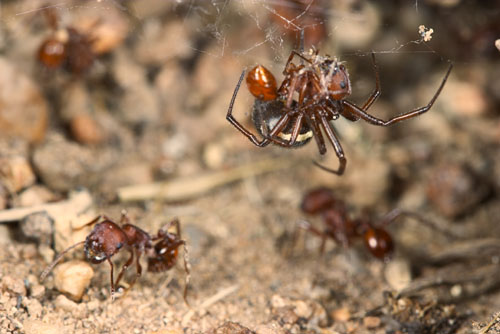
Widow spider and harvester ants. Hallelujah Junction, California
This young black widow (Latrodectus hesperus) set up shop above the nest entrance of a colony of Pogonomyrmex harvester ants. It's an all-you-can-eat buffet, allowing the spider nearly unlimited pickings as the ants come and go.
The spider's mottled coloration is typical of young widows; they don't acquire the striking black and red warning garb until maturity.
photo details: Canon 100mm f2.8 macro lens on a Canon EOS D60
ISO 100, 1/200 sec, f/11, MT-24EX twin flash

It's interesting that the ants don't see the spider as a threat with it set up so close to the entrance.
Apparently, the ants are supposed to have defenses:
http://www.springerlink.com/content/v524u7731084w256/
However, this particular nest had not seemed to recognize the existence of the predator. At least, not during the bit I observed.
How long has the spider been there?
You sure that is a Latrodectus? Looks more like a Steatoda to me(Steatoda are also more commonly found feeding on ants than Latrodectus)...
Anyways, great photo.
Yeah, I spent a fair amount of time looking at the series of photos trying to ID the thing. But, I'm pretty confident that it's Latrodectus. Adults are common as dirt at that site, and one of my photos shows the telltale hourglass on the abdomen (not visible in this shot).